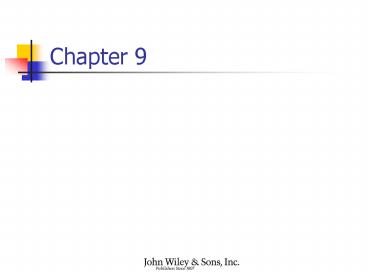Learning Objectives part 1 of 2 - PowerPoint PPT Presentation
1 / 21
Title:
Learning Objectives part 1 of 2
Description:
Adjustable rate mortgage (ARM) 1/1, 3/1, 5/1, 7/1, 10/1. 5 ... Reduces the value of refinancing the mortgage should interest rates drop. Refinancing a mortgage ... – PowerPoint PPT presentation
Number of Views:54
Avg rating:3.0/5.0
Title: Learning Objectives part 1 of 2
1
Chapter 9
2
Learning Objectives (part 1 of 2)
- Explain the advantages of pre-qualification
- Describe the different types of mortgages
available - Ascertain how much you could afford to pay for a
house - Decide how much of a down payment you would like
to make
3
Learning Objectives (part 2 of 2)
- Estimate your closing costs
- Evaluate whether it would be profitable to
refinance your current mortgage - Describe the process by which property taxes are
determined - Evaluate automobile financing choices
- Analyze an auto lease proposal.
4
Advantages of Pre-qualification
- Identifies maximum mortgage one would be able to
obtain - Reduces uncertainty about qualifying for a
mortgage - Adds creditability to a bid (if two bids are
otherwise equal, the one with the prequal. letter
should be chosen
5
Different types of mortgages (1 of 2)
- fixed rate mortgage
- 15-year
- 30-year
- Adjustable rate mortgage (ARM)
- 1/1, 3/1, 5/1, 7/1, 10/1
- 5/25, 7/23
6
Different types of mortgages (1 of 2)
- Conventional mortgage
- FHA-insured mortgage
- VA-guaranteed mortgage
- Jumbo mortgage
- Reverse annuity mortgage (RAM)
7
Elements of an ARM
- Teaser rate
- Convertibility
- Margin
- Index tied to, availability of index
- Caps
- Per each change
- Lifetime
8
Obtaining a mortgage
- Get as many quotes as possible
- Lock period application fees
- Miscellaneous fees
9
Maximum size of mortgage
- Ultimately, lenders choice, but they all follow
certain rules - PITI not exceed 28 of gross income
- PITI and other monthly debt payments not exceed
36 of gross income
10
Selection of down payment (1 of 2)
- Standard is 20 of purchase price
- If less, then will need some form of default
insurance - Any form of insurance is expensive
- If income constraints are a problem then a larger
down payment may make it easier to get a mortgage
11
Selection of down payment (2 of 2)
- Putting more down is equivalent to investing
money risk-free at the mortgage rate - Putting more down may create a liquidity problem
later, that could only be solved with a home
equity loan or through refinancing
12
Closing Costs
- Prepaid interest (for first month)
- Title insurance
- Start escrow account
- Tax Stamps
- Credit report
- Survey
- Potentially many more
13
Choosing a mortgage (1 of 2)
- Fixed vs. ARM depends on risk tolerance, income
constraints, expected period of occupancy - 15-year vs. 30-year depends on reduction in
interest rate vs. opportunity cost of money
14
Choosing a mortgage (2 of 2)
- Paying points to get a lower rate
- Great if paid by employer
- Foolish if occupancy less than five years
(typically) - Depends on opportunity rate of return
- Reduces the value of refinancing the mortgage
should interest rates drop
15
Refinancing a mortgage
- Sometimes done to get at equity in the house
- Popular rule of thumb of 2 reduction vastly
overstates when it can be profitably done - Depends on closing costs and the magnitude of
reduction in the monthly payment
16
Appraised vs assessed value
- Appraised value what an appraiser thinks a home
would sell for - Required by all lenders before a mortgage is
closed - Required for any home-equity loan or HELOC
- Assessed value an arbitrary value assigned to a
home to set property taxes. Unrelated to
appraised value.
17
Property Taxes
- Assessed valuation established
- Each taxing authority establishes a millage rate
(property tax per 1,000 assessed valuation - Some states establish state equilization factors
18
Financing a Car
- Rebate or below market interest rate both are
built in price adjustments, and true value of
BMIR needs to be estimated - Amount of down payment
- Opportunity cost of money
- Reduction in liquidity
- May affect ability to obtain a loan
19
Factors in a lease rate
- Selling price of vehicle
- Expected value of vehicle at end of lease
- Money factor (interest rate)
- Monthly depreciation charge
- Other taxes and fees
20
Down payment on a lease
- Destination charge
- Acquisition fee
- Security deposit
- refundable
21
Borrow buy vs. lease decision
- Monthly down payments lower with a lease
- Leases usually require less out of pocket cash
- Time Value of Money analysis usually favors a
purchase































